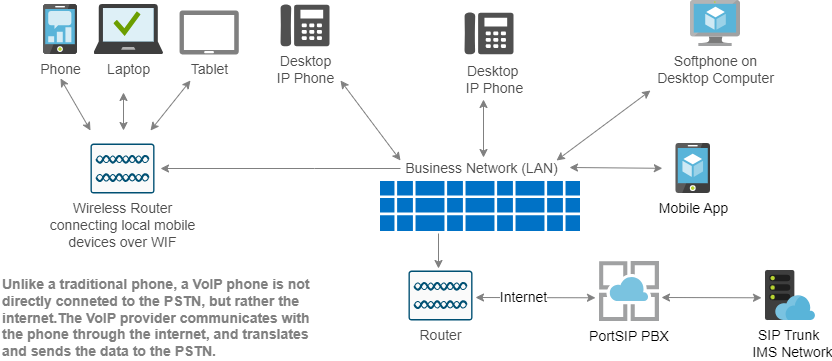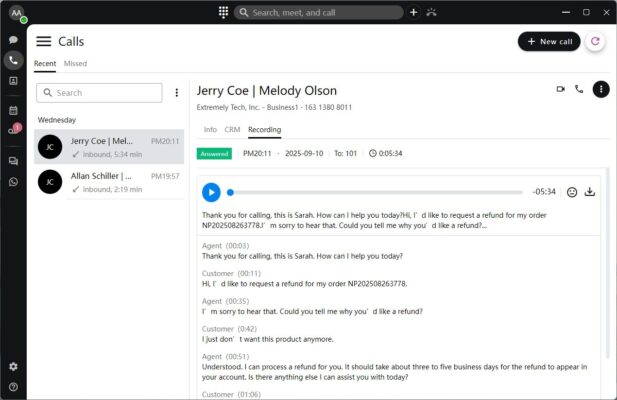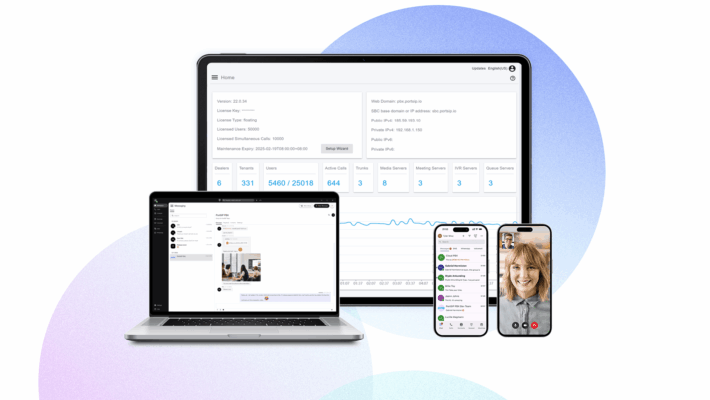SIP (Session Initiation Protocol) Trunking is a cutting-edge technology that facilitates voice and multimedia communications over an Internet Protocol (IP) network, replacing the need for traditional phone lines. It employs SIP, an application-layer protocol, to initiate, modify, and terminate communication sessions between two or more endpoints.
The term “trunking” denotes the amalgamation of multiple communication channels or lines into a single, logical connection, or “trunk.” SIP trunks provide Voice over Internet Protocol (VoIP) connectivity between an on-site phone system and the Public Switched Telephone Network (PSTN).
Consider an office equipped with an existing PBX for phone service. SIP trunks supply phone service for the entire office, enabling them to connect with the outside world.
Implementing your small business PBX phone system via SIP trunking can be cost-effective, but it may not be the ideal solution for everyone. It eliminates the requirement for physical lines and allows for the effortless addition of new phone lines or modification of your phone service without disruptions or the need for new hardware.
SIP trunking has the potential to transform your business by enabling you to upgrade your PBX to a phone system powered by the internet.
It functions in a manner akin to HTTP, the fundamental protocol for browsing web pages on the internet. SIP was adopted by the open-source community and served as a driving force for business phone services. Moreover, the capabilities of SIP extend beyond mere phone service to encompass broader messaging functions.
In the same way that you would subscribe to a traditional phone line from a landline provider, SIP trunking is offered by a SIP provider. This allows businesses to make the transition to digital communication smoothly and efficiently. It’s a significant step towards modernizing business communication infrastructure.
A top-tier SIP trunking service allows you to leverage your existing PBX equipment to transition to a telephone network powered by the internet.
But that’s just the beginning: a SIP phone can also be integrated into your unified communications system. This enables the synchronization of all your communication channels in real time. As a result, productivity, collaboration, and efficiency across your company are significantly enhanced. This is the power of modern, internet-based communication solutions. They not only streamline operations but also foster a more connected and efficient work environment.
How Does SIP Trunking Work?
SIP, or Session Initiation Protocol, is an IP standard established by the Internet Engineering Task Force. It essentially governs how a communication session is initiated and terminated, establishing the connection between IP addresses. SIP technology can also transmit audio, images, video, and documents to support everyday voice calls. This means that SIP users no longer need to maintain two separate networks for data and phone calls. While a VoIP system may use numerous protocols, SIP is the most prevalent.

Understanding SIP Trunks A SIP trunk is essentially a digital counterpart to the analog phone line that many businesses have historically used for making phone calls. SIP enables users to connect one, two, or even twenty SIP channels directly to a business IP PBX, allowing you to make long-distance phone calls via the internet. Utilizing a SIP provider also ensures that those with an on-premises PBX can continue to make unrestricted outbound calls, regardless of the number of calls taking place simultaneously. This flexibility and scalability make SIP trunking a powerful tool for modern business communication.
Benefits of SIP Trunking
Aside from the inherent advantages and the peace of mind that comes with modernizing your business and progressing on the path to digital transformation, there are several benefits of SIP trunking you may not be aware of. Here are just a few:
- Cost Savings Transitioning to SIP might be less daunting than anticipated and could save your business a significant amount in the long run. Traditional local, international, and long-distance calls were subject to varying charges. SIP trunking, however, provides more upfront clarity. Billed on a per-user basis, SIP charges are often bundled together, leading to improved and more manageable cost-efficiency for your teams.
- Network Consolidation Many businesses maintain and pay for data and voice services across separate networks, even if a single supplier provides these services. SIP allows businesses to merge voice and data into a single network, transforming voice calls into a form of data transmission. While this might put a bit more strain on your capacity and connectivity capabilities, it can lead to significant cost savings in the long term.
- Manageable Infrastructure Requirements Unlike businesses using traditional phone systems and services, organizations that switch to SIP can benefit from opportunities to expand their business infrastructure. SIP technology enhances your business’s agility in terms of changes needed to enable a remote workforce. New lines can be added easily, and the entire phone system is much more efficiently managed than with legacy phone systems.
- Scalability and Scope SIP supports your organization’s environment for significant growth. Merging voice and data into one network makes it much easier to enable remote working, helping businesses scale up and attract a talent pool independent of your office’s physical location.
- Unified Communications Switching to SIP can pave the way to further modernize your communications systems. SIP can be the first step towards a more unified communications system. By unlocking the benefits of a fully IP-based suite, modern businesses investing in UCaaS (Unified Communications as a Service) can scale further, enhance productivity and efficiency, and achieve a more global appeal in talent acquisition.
- Mobility Investing in SIP technology allows your organization to enhance the mobility of your teams. The flexibility provided by VoIP apps and other mobile-friendly solutions means that your employees can connect to your on-premises phone system from wherever they are. This has a positive long-term impact on your business continuity as the mobility benefits of SIP and VoIP solutions ensure communications can be maintained even if your internet connection fails.
- Business Continuity SIP allows businesses to be more resilient, with a business phone system that is more reliable than legacy systems. In the event of unpredictable disruptions or outages, SIP users can divert calls to another site or system so that business can continue as usual. Given the increasing importance of not missing a call, SIP technology can play a significant role in any business’s disaster recovery plans.
What is a Direct Inward Dialing Number (DID)?
When talking about SIP trunking, we can’t ignore Direct Inward Dialing (DID).
Using a DID service, your telephone service provider connects your company’s PBX to a block of telephone numbers. With this feature, businesses can set up virtual numbers that bypass the main reception line and go directly to an extension or group of extensions in a particular company.
With a DID number, you can easily manage multiple phone lines and extensions without the need for physical phones. This can help you save money on your phone bills and hardware while keeping your communication streamlined.
How is it connected to SIP trunking? To put it simply, your DID number first identifies your phone. Then, SIP trunks serve as the link between that identified phone and the Internet. Through the SIP trunk, a DID is connected to the Internet. This DID then allows calls to be forwarded to the right phone.
Choosing the Right SIP Trunking Provider
The SIP Trunking needs of your company will depend on the existing equipment, desired features, and the locations of your users. The setup process will vary based on the provider you select. In this section, we’ll provide a brief outline, followed by a more detailed breakdown.
Quick Setup Overview for Your SIP System
- Decide if you want to repurpose any of your current hardware, such as a landline PBX system or IP PBX.
- Compare providers and identify any additional equipment you may need.
- Collaborate with your provider to purchase phone numbers and set up your account, IP, and routing information with SIP.
Detailed Breakdown of Setting Up Your SIP Trunking Infrastructure
- Determine Business Communication Goals: Before selecting an SIP provider and the necessary equipment, outline the business goals you aim to achieve with your SIP Trunking phone system. For more complex and diverse business needs, a hosted SIP Trunking solution or VoIP phone system might be more suitable.
Consider the following:
- Channels: Do you only need voice calling, or do you also want UCaaS capabilities like SMS texting, video conferencing, and internal team messaging? If you require multiple communication channels, an IP PBX system or a hosted solution for Trunking might be a better fit than converting a legacy PBX infrastructure.
- Phone Number Needs: Do you only need phone numbers in your local area code, and domestic numbers, or do you also want international numbers? Do you want toll-free and vanity numbers? Your answers will influence which provider you choose, as each provider offers unique phone number options.
- Routing: What are your routing needs for inbound calls? Do you plan to use an IVR menu, or simply route inbound calls to any available user? If your team has complex routing needs and wants IVR, you might be better off opting for a virtual or IP PBX-based SIP Trunking solution, rather than converting a legacy PBX system.
- Use Cases: Do you plan to use your phone system for customer support, sales, or basic customer-facing communication? Your answer will affect the routing tools, analytics, and sales campaign features you may need.
- Call Volume: How many calls do you expect to make per day? During a standard business day, how many team members may simultaneously handle a phone call? These answers will determine whether Elastic or Regular SIP Trunking offers more efficient pricing for your call volume.
- Take Inventory of Your Current Setup: Consider the communications infrastructure you currently have in place, and which equipment you can repurpose for your SIP Trunking system. You may be able to reuse routers, VoIP phones, IP PBX systems, computers, and session border controllers (SBC) with most SIP providers.
You may also be able to repurpose a legacy PBX system for SIP Trunking, but this setup often requires additional hardware, like an analog telephone adapter (ATA) and SBC. These tools link your PSTN connection to the internet, enabling SIP. Converting a legacy landline system to SIP Trunking can be expensive and leave you with high-maintenance equipment. In most cases, you’re better off abandoning your legacy PSTN equipment and opting for a virtual SIP Trunking infrastructure, either with a physical IP PBX box or a hosted software setup.
- Compare Providers: Once you’ve determined what equipment you may be able to repurpose, begin researching SIP Trunk providers. Look for a system that accommodates your equipment and your business goals, while requiring minimal additional hardware.
Work with each provider to determine what your setup process may look like. Tell them the equipment you need, how many SIP Trunks or virtual lines you’ll require, and your communication goals. Get an idea of what your system would cost with each provider, and which VoIP or UCaaS capabilities each setup would provide.
When comparing SIP Trunk providers, consider the following:
- Pricing: Determine the cost of each SIP trunk (virtual phone line) with each provider. Many providers offer regular SIP Trunking charged monthly per line, and Elastic SIP Trunking that is charged per minute.
- Compatibility with your current setup: Speak with each provider, telling them about your current equipment. Determine if the provider’s offerings accommodate your equipment, if you’d need to purchase more hardware, and if your staff is up to the task. Many providers offer additional hardware and can assist with setup.
- Feature availability: Ask about the features that each provider’s SIP Trunking solution supports. Determine how easily you can set up features like a routing system with phone extensions, IVR menu, voicemail, call recording, and analytics.
- Phone number offerings: Learn about each provider’s phone number offerings, determining if they offer toll-free numbers, local numbers in your desired area codes, or international DID phone numbers.
- Determine What Additional Equipment You May Need: When choosing a provider, be sure to communicate the details of your current infrastructure to get an in-depth picture of how your SIP Trunking setup process will look.
Ask your provider what additional hardware you may need:
- IP PBX systems–physical hardware or virtual
- VoIP phones and cables
- Analog telephone adapter (ATA) if converting a landline system
- Session border controller (SBC)
If choosing a software-based system or using an IP PBX, ask your provider if the setup requires any programming knowledge or an on-site developer. If you feel unprepared for any of these steps, ask if the provider offers any assistance with setup.
- Work With Your Provider to Install SIP Trunking System: Since there’s so much variability between each company’s SIP Trunking setup needs, most SIP Trunking providers offer individualized installation support.
Establish a contact from your provider, who can walk you through each step of the process:
- Purchasing and installing hardware
- Purchasing and setting up SIP trunks
- Purchasing and registering phone numbers and assigning them to users
- Customizing extensions, routing, call controls, and IVR menus
- Customizing programming and code for any APIs, additional features, or integrations required
- Assisting agents or supervisors with using the new VoIP system’s interface and features
Although setting up SIP Trunking can feel overwhelming, a SIP system is generally low-maintenance once you get it set up. SIP Trunking providers offer 24/7 support over phone and email, to ensure your new system runs smoothly.



